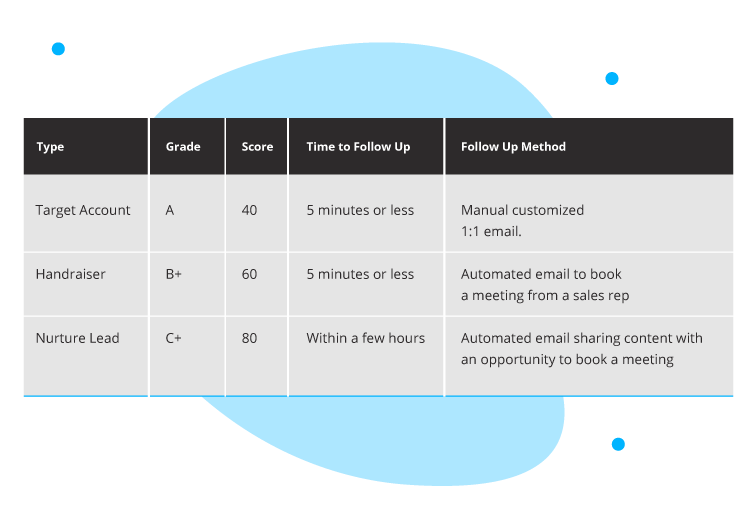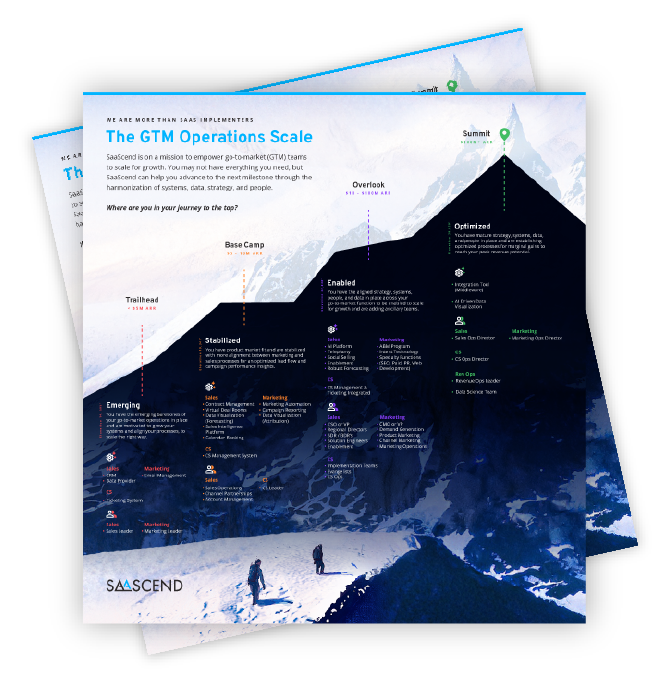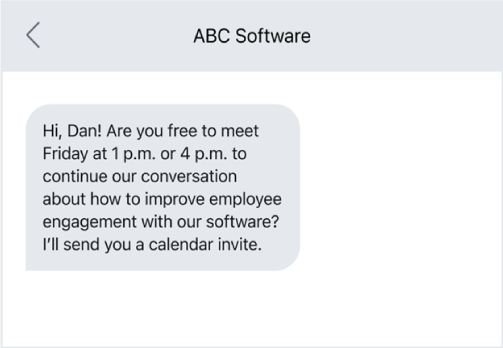Most leads will not buy from you instantly, which makes sales lead follow-up a crucial component of the sales process. In fact, 60 percent of customers say no four times before they say yes to a sales pitch, but a whopping 48 percent of sales representatives never attempt a single follow-up.
That’s where a solid sales follow-up strategy can help. It will allow you to build relationships with leads and close more deals to reach your sales goals. Plus, it ensures you are not leaving money on the table.
In this article, we’ll cover nine best practices for a sales lead follow-up and share follow-up templates across email, text, and phone.

9 sales follow-up best practices
#1
Respond quickly to inbound inquiries
Studies show that speed to lead is vital to closing deals. In particular, companies who reach out to a new lead within an hour are seven times more likely to have a sincere conversation with decision-makers than those who wait longer. A separate study from Lead Connect found that 78 percent of customers buy from a company that responds to their inquiry first.
One key to responding quickly is using a communication channel that makes rapid communication possible, like business texting, a phone call, or email.
The average business text message has a response time of 90 seconds and is designed for quick two-way conversations. This makes it a great option for lead follow-ups.
MASTERCLASS
Accelerating Speed to Lead with Optimized Routing
#2
Categorize your leads to personalize messaging
Categorizing leads will look different for each business, but the process will help your sales team better personalize messages and prioritize following up with the potential customers most likely to convert. In addition, each type of lead will require a different approach. For example, a lead that filled out a contact form on your webpage is at a different point in the sales funnel than a lead that came from a cold email.
As a result, it is important to segment your leads and ensure your follow-up approach differs depending on the category. One example of a way to segment your leads is into hot, warm, or cold. Hot meaning they are ready to buy, warm meaning they have potential, and cold meaning they may need a bit more nurturing before they are ready to buy (fig. 1).

Another way a sales team could categorize is by segmenting their leads into high-value, strategic, and smaller accounts. Again, the key is to approach lead follow-up based on lead quality and type (fig. 2). You could also categorize your leads by how they plan to use your product, by their buyer persona, or other characteristics, to improve message personalization.
For example, suppose you sell a product such as a campaign attribution platform. In that case, you can categorize your leads by their buyer persona, segmenting VPs and CMOs who will be focused on gaining insights for smarter budget allocation from marketing managers and associates who will be focused on campaign execution and understanding performance to inform their future strategy.

Once you group your leads, you can send follow-up messages specific to their problems for a better chance of converting them. Categorizing your leads helps sales teams prioritize outreach and makes it easier to tailor a message to them, which leads expect from companies nowadays. Personalization can lead to revenue growth between five percent to 15 percent, according to a McKinsey & Co. study.
#3
Be persistent with following up
A major key to sales success is persistence. It often takes time to warm up a lead, so you’ll likely need to follow up several times to close a deal. Remember, it takes an average of five follow-ups for most leads to convert.
One way to ensure your sales team is persistent is to leverage automated sequences using sales engagement platforms like SalesLoft, Outreach, Groove, or Textline. This approach is especially useful with warm or hot leads that reached out but didn’t respond to the first follow up. These automated sequences may differ by company, but here’s an example of what a follow-up sequence could look like:
-
-
-
- Day 1: Initial follow-up
- Day 3: Follow-up 2
- Day 7: Follow-up 3
- Day 14: Follow-up 4
- Day 28: Follow-up 5
- Day 100: Check in to see if they are interested now that time has passed
-
-
While there is no perfect formula for sales lead follow-ups, reaching out daily is a big no-no. Following up too frequently can come off as pushy or aggressive, putting a lead off your brand completely. On the other hand, too few interactions won’t lead to a conversion either.
#4
Use multiple communication channels
Using a mix of communication channels to follow up can help drive leads through the buying process, improve response rates, and meet customer preferences.
Specifically, each lead will prefer a different communication channel, and each communication channel can serve different purposes, so it helps you meet them where they are. For example, business texting is great for fast introductions, quick check-ins, and highly qualified leads, while phone calls, Zoom meetings, and emails are better for more in-depth conversations.
In addition, don’t forget to use social networking sites like LinkedIn to reach out or connect with your leads. LinkedIn is an excellent way to reach leads because it is where many of your leads could already be spending their time.
#5
Implement a CRM platform
Sales representatives handle multiple leads simultaneously, which can overwhelm without proper organization. Using a customer relationship management platform, like Salesforce or HubSpot, can help you manage external interactions, including lead follow-up, to drive success.
There are numerous benefits to using a CRM platform. For starters, a CRM solution can bring together siloed departments, like customer success and sales, even if your team is spread across the globe. Eighty percent of business leaders say they increasingly use their company’s CRM as a single source of truth about their customers across departments.
As we mentioned earlier, it’s important to categorize and group leads to make follow-up more personalized. A good CRM platform can help you easily categorize leads and track their engagement with messaging no matter the communication channel.
Overall, the benefits of a CRM solution are widespread as it can increase efficiency and transparency to close more deals and save your organization money.

Invest in the Right Sales Technology for Your Current Business Stage
#6
Understand when to use automation or a manual human touch
Similar to understanding what communication channels to use, it’s important to know when to use automation versus stepping in with a personal touch. The reality is sales is still a human-centric business, so while automation can help teams reduce repetitive, manual tasks, it can’t replace all human touches.
When it comes to automating follow-ups, an automated email or text message could be a great way to reach multiple leads simultaneously. Still, it’s a good idea to step in with a more personalized message at times. This connects back to categorizing your leads. For example, a warm lead that may not be closely aligned to your Ideal Customer Profile could receive an automated follow-up, where you would always want to give your target accounts the white glove treatment with a manual customized follow-up.
Manual vs. automated follow-up can also depend upon the level of intent the prospect exhibits. Take, for example, when someone fills out your contact us form that closely aligns with your Ideal Customer Profile. This prospect is a good fit for your business showing interest in your product or service. As a result, you may want a real person to follow up with the lead to create a good first impression. On the other hand, following up on an initial cold email to a non-strategic account could be something that is done with automated follow-up email sequences.
Another example is during the onboarding process for sales account managers. You can automate parts of the onboarding process with documents or videos, but it’s crucial to have a sales representative walk through your product or service with a customer post-sale to ensure the customer’s needs are being met. Plus, you want to ensure your customer understands how to best use your product or service. If a customer doesn’t use your product or service to its full potential, they are more likely to churn.
#7
Nurture your leads with useful content
Leads need time to be nurtured to help them become familiar with your company and decide to purchase your product or service.
A great way to relate to leads is to share relevant information and content that is directly related to helping the prospect solve a particular challenge that is top of mind to them. This type of content can be anything from a blog post to an infographic or video content. You don’t have to limit yourself to company-specific content. Anything relevant to your lead can work.
For example, if you were to connect with a lead looking for employee engagement software, you can send them a guide on how rewards and recognition can improve employee engagement.
Another way to ensure your content is relevant is to utilize lifecycle stage tracking. Lifecycle stage tracking lets your company know how close a lead is to closing because it identifies their particular stage in the funnel. Leads further in the buyer journey, at the Sales Accepted Lead or Sales Qualified Lead stage, will benefit from more bottom-of-funnel content like a case study, whereas leads higher in the funnel at the Prospect stage will appreciate more top- or middle-of-funnel content, like an educational blog post (fig 3).
#8
Always include an agreement on the next steps
Each follow-up message or call should have a clear next step. An agreement is important to let leads know what you expect from them. Without a clear next step, leads are less likely to reply because they simply don’t know what you want from them.
You want to be specific with your agreement on the next steps. Instead of asking if a client is free next week, specify a time and date to meet and include what the conversation will entail (fig 4).
#9
Know when to stop following up
While follow-ups are necessary to win leads, it’s important to know when to stop following up. If a lead is showing no interest or response after the fifth follow-up, they’re likely not going to change their mind.
But that doesn’t mean you have to give up on the lead entirely. While they may not be ready to buy at the moment, they might be interested in the future. You can send unresponsive or uninterested leads an email telling them that you will stop reaching out but will follow up with them again later in the year to see if their business needs have changed.
That’s another reason it’s crucial to log your leads in a CRM platform, so you can reach out to a lead after a few months to see if they are interested. From the CRM, you can then enter the lead into a marketing nurture campaign helping to keep your brand top of mind over the next few months, leading up to the next time you follow up.
If the lead does not respond the next time you follow up after that, or they have not engaged in any marketing nurture campaigns, the sales representative can enter them into a Zombie Nurture program. This is a technique you can use to sunset unengaged prospects that are taking up space in your database. Your zombie email calls out that they have not engaged in a while and asks if they would like to be unsubscribed or have their email preferences updated, pointing them to your Email Preference Center (EPC). If they do not engage with your Zombie email, then you can add them to a list that needs to be archived.
Templates for lead follow-up by communication channel
❶ Follow up after an initial email
Hi {{First Name}},
I’m following up on my last email in case it got buried in your inbox. Would you still like to move forward with a product demo?
If yes, let’s get a time booked on the calendar for us to connect. I look forward to learning more about your business and sharing how our attribution platform can help make an impact.
Here is the link to my calendar to confirm a time that works best.
Best,
{{sender.name}}
❷ Follow up after a demo
Hi {[First Name}},
Thank you for taking the time to connect and allowing me to learn more about your company goals. I hope the demo was beneficial, but feel free to reach out if you have any questions.
I’ve attached a recording of the demo as well as a case study from one of our customers with a similar use case.
Let’s touch base in a week to discuss the next steps. How does {{date}} at {{time}} work for you?
Best,
{{sender.name}}
❸ Follow up after no sale
Hi {{First Name}},
It’s been a pleasure speaking with you and your team. I understand now is not a good time to implement our solution. I will plan to follow up with you in 90 days to see if we’re a better fit for each other then.
Please feel free to reach out if things change in the meantime.
Best regards,
{{sender.name}}
Text message follow-up templates
❶ Follow up after email
Hi {{First Name}}. This is {{Salesperson}} texting you from {{Company}}. I just sent you an email, but I also wanted to follow up on text if it’s more convenient for you.
❷ Follow up after meeting and during a free trial period
Hi {{First Name}}. I hope the meeting was helpful! Feel free to reach out if you have any questions as you try out our product, and I’ll sync with you on {{date}}.
❸ Follow up after no sale
Hi {{First Name}}. I understand now is not a great time to implement our solution. I’ll plan to reach out later this year to see if your needs have changed!
For more examples of sales text message follow-ups, check out this article, “18 sales follow-up text message templates to engage prospects.”
Call script follow-up templates
❶ Follow up after email and text
Hi {{First Name}}, it’s {{Salesperson}} from {{Company}}. I just wanted to check in and see if you saw my last email and text message.
We offer solutions to businesses similar to yours, and I think {{Client’s Company}} can benefit from our {[Product/Service}}.
Can we get 30-minutes on the books on {{Date}}? I can walk you through a personalized demo of {our product/our service}} based on your needs.
❷ Follow up after the demo
Hi {{First Name}}. Thanks for taking the time to walk through our demo today! I will email you a copy of the recording and a few other materials so you can share them with the relevant stakeholders at your company. Let’s schedule a meeting for {{date}} to discuss the next steps. I’ll follow up with my availability in the email. Take care!
❸ Follow up after closing a deal
Hey {[First Name}}. We’re happy to have you on board! I’ll be here for you as we transition your account over to our customer success team. In the meantime, I sent you an email with a copy of our documents and a few onboarding videos to help you get started.
I think it’ll be beneficial to walk through the product together with your team, so I can answer any questions they may have. Let me know what time works best for you. It would take roughly an hour.
Congrats again, and I look forward to working together.

“My time is freed up to focus on coaching my sales team for success.”
How to hold sales teams accountable for follow up
There are many ways to hold your sales team accountable for following up with leads, but a few are:
-
-
- Define what follow-up success looks like for your company and include it in your Service Level Agreement with marketing
- Set goals and incentives for each representative
- Hold regular meetings with your sales reps to troubleshoot and refine their follow-up approach
- Use a tool like a CRM platform to help track sales activities to gain better visibility into lead follow-up and identify trends that lead to deals in the pipeline
- Enable your sales team to take ownership of the process by providing proper training
-
The bottom line
Remember these best practices the next time you follow up with a lead. By using a mix of these tips, you’ll be able to drive your sales team to success.
Customer Success Story
Find Out How Remote Year Used Textline to Reach More Leads

